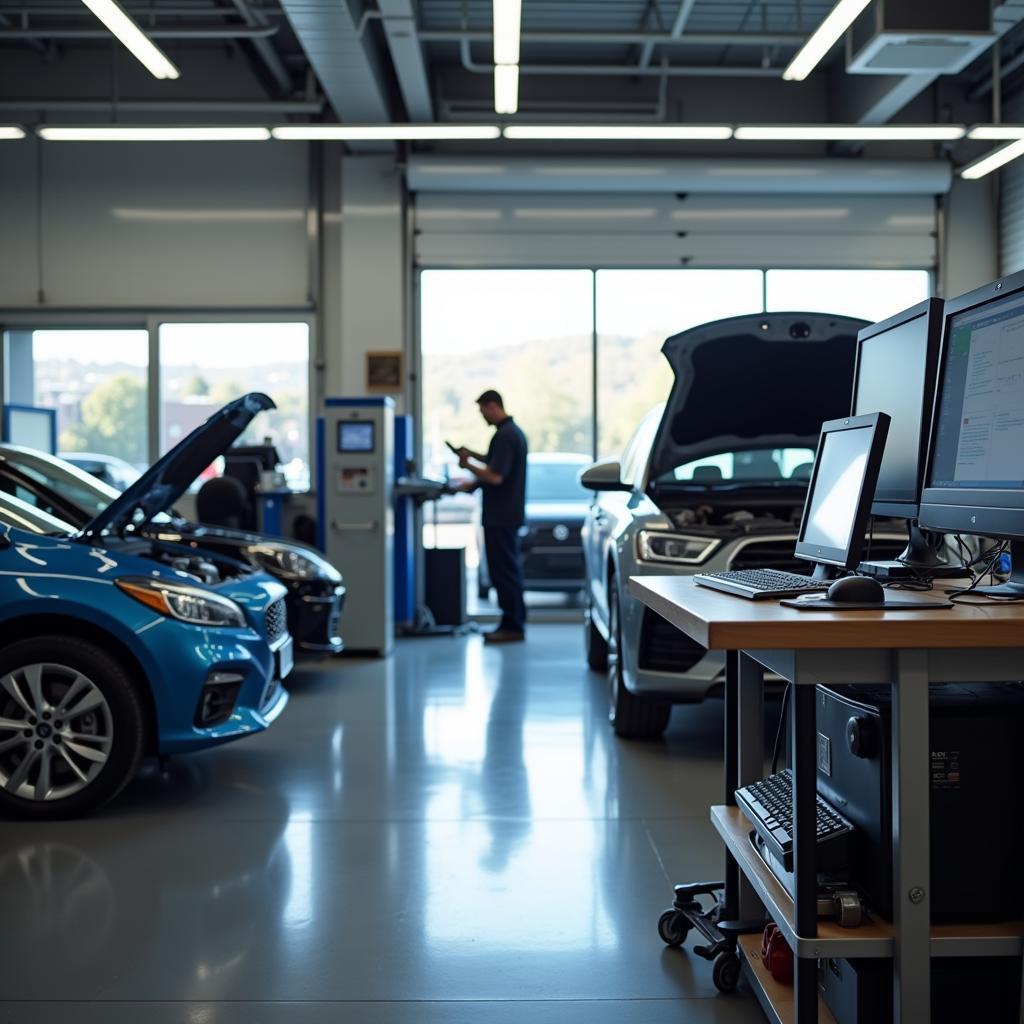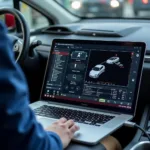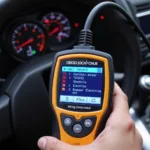That dreaded check engine light has illuminated your dashboard, casting a shadow of doubt over your next drive. Understanding what car repair shops do when diagnosing this warning is crucial for every car owner. Don’t panic! This article provides a comprehensive guide to understanding the check engine light and what happens when you take your car to a light car repair garage.
Why is My Check Engine Light On?
The check engine light, also known as the malfunction indicator lamp (MIL), is part of your car’s onboard diagnostic system (OBD-II). It can signal a wide range of issues, from a loose gas cap to a more serious problem like a failing catalytic converter. Ignoring it can lead to costly repairs down the line.
Common Reasons for the Check Engine Light
- Loose or Damaged Gas Cap: This is a surprisingly frequent culprit. A loose gas cap can allow fuel vapors to escape, triggering the check engine light.
- Faulty Oxygen Sensor: Oxygen sensors monitor the exhaust gases and help regulate the fuel mixture. A malfunctioning sensor can affect fuel efficiency and emissions.
- Catalytic Converter Problems: The catalytic converter reduces harmful emissions. If it’s failing, it can significantly impact your car’s performance.
- Mass Airflow Sensor Issues: This sensor measures the amount of air entering the engine. Problems with it can affect fuel economy and engine power.
- Spark Plugs or Ignition Coils: Worn-out spark plugs or faulty ignition coils can cause misfires and decrease engine performance.
What Happens at the Car Repair Shop?
When you take your car to a car repair shop for a check engine light diagnosis, the technician will typically follow these steps:
- Connect an OBD-II Scanner: This tool plugs into your car’s OBD-II port and retrieves diagnostic trouble codes (DTCs) stored in the car’s computer.
- Interpret the DTCs: These codes indicate the specific area or system where the problem is detected. However, they don’t always pinpoint the exact cause.
- Perform a Visual Inspection: The technician will visually inspect the related components for any obvious signs of damage or wear.
- Conduct Further Testing: Depending on the DTCs and the visual inspection, the technician may perform additional tests, such as checking fuel pressure, testing sensors, or using specialized diagnostic equipment.
Understanding Diagnostic Trouble Codes (DTCs)
DTCs are five-character alphanumeric codes. The first character indicates the system (e.g., “P” for powertrain, “B” for body, “C” for chassis, “U” for network). The remaining characters provide more specific information about the problem. A qualified technician can interpret these codes to diagnose the issue.
How to Choose a Reliable Car Repair Shop for Check Engine Light Diagnostics
Choosing the right albany light truck and car repair albany ny is crucial for accurate diagnosis and repair. Look for shops with:
- ASE Certified Technicians: ASE certification indicates a technician’s knowledge and skills.
- Positive Customer Reviews: Check online reviews and testimonials to gauge customer satisfaction.
- Up-to-date Equipment: Modern diagnostic equipment is essential for accurately diagnosing complex car problems.
- Transparent Communication: Choose a shop that clearly explains the diagnosis and repair process.
How Much Does Check Engine Light Diagnosis Cost?
The cost of a check engine light diagnosis can vary depending on the shop and the complexity of the problem. Some shops offer free diagnostic scans, while others may charge a fee. Car engine light repair duluth ga may have different pricing than your local area. Be sure to inquire about the cost upfront.
 Modern car repair shop with diagnostic equipment
Modern car repair shop with diagnostic equipment
Conclusion: Addressing the Check Engine Light Promptly
The check engine light is a valuable warning signal that shouldn’t be ignored. By understanding its potential causes and the diagnostic process at car repair shops, you can take proactive steps to address any underlying issues and keep your car running smoothly. Don’t delay – schedule an appointment with a reputable car light repair near me as soon as the check engine light illuminates. Addressing the issue promptly can save you money and prevent more serious problems down the road.
FAQ
-
Can I drive my car with the check engine light on? It depends on the severity of the problem. Sometimes, it’s safe to drive for a short distance, but it’s always best to get it checked out as soon as possible. Car brake light repair near me may help you find a qualified mechanic quickly.
-
Will the check engine light reset itself? Sometimes, it can, especially if the issue was minor and has resolved itself. However, it’s still a good idea to have it diagnosed to be sure.
-
What is the OBD-II port? It’s a standardized diagnostic port found in most cars manufactured after 1996. It allows technicians to access diagnostic information from the car’s computer.
-
How often should I have my car checked for diagnostic trouble codes? It’s a good practice to have your car scanned for codes during regular maintenance checkups.
-
Can I diagnose the check engine light myself? You can purchase an OBD-II scanner and read the codes yourself, but interpreting them and diagnosing the problem accurately requires expertise.
-
What if the check engine light is flashing? A flashing check engine light indicates a serious problem that requires immediate attention.
-
Can a loose gas cap really cause the check engine light to come on? Yes, it’s a common cause.
Need further assistance? Contact us via WhatsApp: +1(641)206-8880, or Email: [email protected]. Our customer service team is available 24/7.


